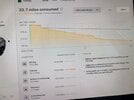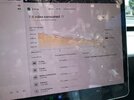Is that the actual travel time or are you just estimating from maps?
I agree with the others, post your actual wh/mi from the trip meter (which should include travel time also). That makes it easier for others to compare to their own consumption numbers without relying on assumptions the energy app may be making.
You can display the trip meter by going to Controls > Trips
For the current trip it would show display distance, duration and average energy usage.
For since last charge it can show distance and total and average energy.
Model 3 Owner's Manual | Tesla
Up thread you already have some numbers to compare to: 230 Wh/mi without AC, 400-500+ Wh/mi with AC blasting on LO.
The only thing I can contribute is my own recent trip with no AC is 210 Wh/mi (I have a 2021 Model 3 SR+).




